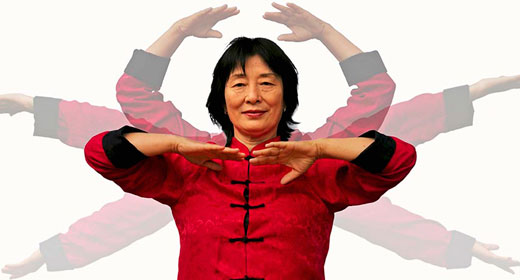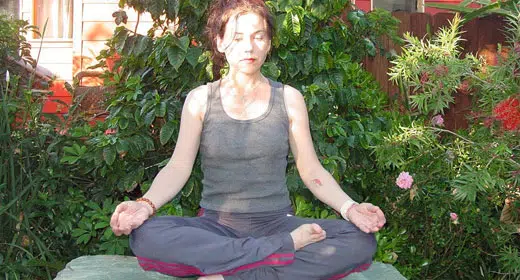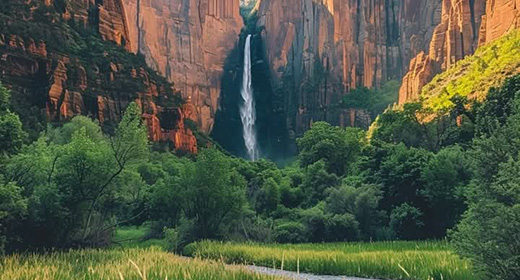by Adam Brady: While a spiritual awakening is often considered a journey, it’s not necessarily a journey of physical travel or pilgrimage; it’s a process of going beyond your boundaries and taking the next evolutionary step…
In the course of a human life, few experiences can be as profound and transformative as those of a spiritual awakening. Identifying with and directly experiencing your divinity represents a paradigm shift of the highest order. A spiritual awakening has the potential to rip apart the fabric of reality as you’ve known it and pull you forward into a new life of conscious growth and evolution. As the term implies, you “wake up” from the dream of everyday, mundane material-level, ego-based awareness to a higher reality of spirit. And as if emerging from a deep sleep, you can see the dream for what it is—an illusion to which there can be no going back.
Escaping Ignorance
A spiritual awakening represents the lifting of the veil of ignorance or avidya, which in Sanskrit means “incorrect understanding.” This ignorance shrouds your true nature and keeps you operating in the dark of lower levels of consciousness. This is a state of not knowing what you don’t know. At the heart of this ignorance is tamas, one of the three gunas, or primary qualities of the universe. Tamas embodies darkness, dullness, inactivity, and entropy and binds you in the physical, mental, and emotional quicksand of inertia. Fortunately, though, the process of spiritual awakening runs directly counter to the currents of avidya in your life. The evolution of consciousness generates a forward pull, a momentum toward growth, transformation, and change that is one of the most powerful forces in the universe. Like a spaceship achieving escape velocity, spiritual awakening punches you out of the limiting gravity well of ignorance and on toward the ultimate destination of cosmic self-realization.
But how does this happen? Well, if you accept that all human beings, and perhaps even all sentient beings, are hardwired for evolution, then it stands to reason that spiritual awakening is your birthright—something you are destined to achieve. And if this process is mapped into your consciousness and your body, then there must be clues or steps to indicate you are on the path to awakening.
The Vision of Your Spiritual Journey
One of the most useful metaphors for describing the stages of spiritual awakening is that of vision. In this model, five different qualities of sight represent unique steps on the spiritual journey:
- Glimpsing: The call to adventure
- Closer examination: Choosing a path
- Seeking: Following the path
- Loss of sight: Losing the path
- Seeing: Merging with the path
Let’s explore each of these stages in greater detail.
1. Glimpsing Spirit: The Call to Adventure
The celebrated mythologist Joseph Campbell defined what is known as the hero’s journey, an evolutionary path of growth and transformation woven into all great myths and stories: “When we quit thinking about ourselves and our own self-preservation, we undergo a truly heroic transformation of consciousness.”
At the start of any hero’s journey is the primary pushing off point known as the call to adventure. The call to adventure represents a break from everyday life, a signal that bubbles up from the subconscious, catches your attention, and leads you in a new direction. A call to adventure is the spark that triggers a spiritual awakening. Every life has a moment, if seized, that will change that life forever. The call to adventure is an awakening incident, a new perception that compels you to look at life differently. This spiritual experience can take countless forms—a trip to a faraway land, the loss of innocence, an illness, a challenge, the death of a close friend, a near-death experience, or the loss of a job. Regardless of the particulars, the experience shakes your worldview and you see the world with new eyes. You are called to live the ordinary life in a non-ordinary way.
At this pivotal point, Joseph Campbell teaches that you face a choice, to either accept or refuse the call to adventure. In reality though, refusing the call truly isn’t an option, because at the deeper level, your own soul is beckoning you to transform. If you refuse the call, thanks to your unique karmic influences, the opportunity will only recycle itself like a skip on a record, patiently waiting for you to accept the call to a new life. In addition, once a transformative and deeply awakening incident has been experienced, there can be no going back. Your eyes have been opened and you can’t un-see the vision of the higher reality calling to you, no matter how much you might want to deny it.
Once you have answered the call to adventure, you step into a larger world. You become a conscious participant in your spiritual growth and evolution. Responsibility becomes the operative word as you begin to navigate your life toward opportunities that further expand your awareness. A subtle shift in perception has taken place and everything feels the same and oddly different simultaneously.
2. Closer Examination: Choosing a Path
Faced with the realization that your limited worldview can no longer contain your expanding awareness, you come to recognize that your life is on a spiritual journey, an awakening of your consciousness. While it can be an exciting time, this stage can also feel unsettling and unfamiliar. Everything you once accepted as fixed and stable (ideologies, worldviews, sense of self and others, relationships) can be called into question. You are in search of answers—a means by which you can repeat or return to the glimpse of spirit that initially shifted your perspective.
At this point, you may set out to find a new way—a new philosophy, a different tradition, or practice that will help to contextualize or re-map your worldview. This is when many begin spiritual exploration in earnest. Often marked by a period of information gathering, self-study, and delving into world religions or psychology, you are drawn to practices and methods that align with your unique personalities and dispositions. According to Vedanta, there are four paths or yogas back to the unity you seek:
- Bhakti Yoga: The path of love and devotion
- Jnana Yoga: The path of science and the intellect
- Karma Yoga: The path of action and selfless service
- Raja Yoga: The path of meditation and all its related disciplines
Each path provides a distinctive vehicle for self-discovery and realization. Some may choose one, others may explore multiple paths simultaneously; there are no absolutes or set rules for discovering your path. What matters is that it feels right for you and serves as an appropriate vehicle for growth. No one can or should tell you what path to follow; only your own intuitive heart can guide you to what method or vehicle will suit you best. At this stage you would do well to remember the wisdom of the Hindu proverb that states:
There are hundreds of paths up the mountain, all leading to the same place, so it doesn’t matter which path you take. The only person wasting time is the one who runs around the mountain, telling everyone that his or her path is wrong.
3. Seeking: Following the Path
The next stage calls you to be a spiritual seeker. Having found your path, regular practice, study, and discipline serve to take you deeper toward the greater vision of expanded awareness. The Sanskrit term for the discipline of spiritual practice is sadhana. Sadhana is the spiritual routine that takes your practice from an isolated exercise to a way of life. You are dedicated travelers on the path, familiar with its twists and turns, up and downs. As your practice deepens, you become increasingly more adept and more knowledgeable, not only of the tradition or practice you follow but also of yourself.
This stage is marked by the birth of self-referral, the process in which your identity begins to shift from external references (such as positions, possessions, and ego satisfactions) to the internal reference of stillness, intuition, and higher guidance. You know yourself as a spiritual being living a human life while fostering the progressive growth of your consciousness.
As you travel their path to expanded awareness, there are two markers, two clues that hint spiritual progress is underway.
- The first is an increasing sense of lightheartedness. With consistent spiritual practice, happiness and joy become your ground state. You take life less seriously. Hysteria and melodrama have less influence over you. Carefreeness and detachment flow from you spontaneously and you feel much more at ease in life.
- The second marker of spiritual progress is the ease in which your desires are fulfilled. Regular spiritual practice removes mental, physical, and energetic blockages that obstruct the manifestation of your desires. As these obstacles fall away, life becomes easier; you step into the flow of life and experience synchronicities, little miracles, and experiences of grace that lead you closer to your life’s spiritual purpose.
4. Loss of Sight: Losing the Path
The spiritual path is not without struggle, however. By its very nature, the path of awakening confronts you with your shortcomings, self-deceptions, cognitive biases, and resistance to change. Growth can be an uncomfortable process at times. As your chosen path challenges you to change thoughts, emotions, speech, or behavior to be more expansive, compassionate, forgiving, or kind, it is not uncommon to struggle with being in this world but not of it. Worse yet are the external influences that assault the spiritual seeker with temptations to give up the quest for awakening and return to a conventional life.
The most formidable challenges on the path come in the form of what Joseph Campbell called threshold guardians. Threshold guardians are the barriers (literal or symbolic) that stand in the way of important turning points in your life. They can be enemies, rivals, life circumstances, limiting beliefs, or setbacks that block your progress forward toward a higher level. These antagonists can repeatedly knock you down, test your resolve, and make you question your chosen path. Such setbacks make you doubt yourself and your commitment and may even persuade you to give up the quest.
At this stage, you may feel lost or helpless, as if you have succumbed to spiritual blindness. However, what you often don’t realize is that this blindness or challenges are the subterfuge of your ego—your small self that fears its own extinction in the ever-expanding field of spirit. Seen in this way, your spiritual challenges, or dark nights of the soul, become as spiritual teacher Ram Dass would say, “grist for the mill of enlightenment.” Every setback then becomes an expression of your inner doubts and fears—trials and hurdles on your personalized and self-made obstacle course.
Undoubtedly, this stage requires both fortitude and courage to stay on the path as you remember poet Robert Frost’s words: “The only way out is through.” Fortunately, it is from this darkness that you can emerge fully into the light, continue your spiritual development, and become awakened.
5. Seeing: Merging with the Path
At last, the seeker breaks through to a new stage; visionary, transcendent, and sight beyond sight. At this level you have gone beyond sadhana; you have become the practice. No longer striving to see, you exist in a state of unity in which seer, scenery, and that which is seen merge. A permanent shift has taken place and you awaken fully to your true identity—the infinite, immortal, unbounded, God-force existing everywhere and in everything. You wake up fully to being the divine observer—the ever-present witness-self of the entire universe.
In this stage, you come back home to yourself, but surprisingly, the process isn’t one of accumulation or gaining more knowledge or experiences. Instead, it’s a process letting go, of continual decrease. Like peeling the skins of an onion, the “you” gets smaller and smaller until only pure being-ness remains. It’s a journey of insight from here to HERE. This is the sign of spiritual awakening.
The path of spiritual awakening is the grandest adventure you can ever undertake. You are deeply privileged just to recognize the truth that such a journey stands before you. And embracing it is nothing less than following the heroic call of your life purpose and destiny.









































